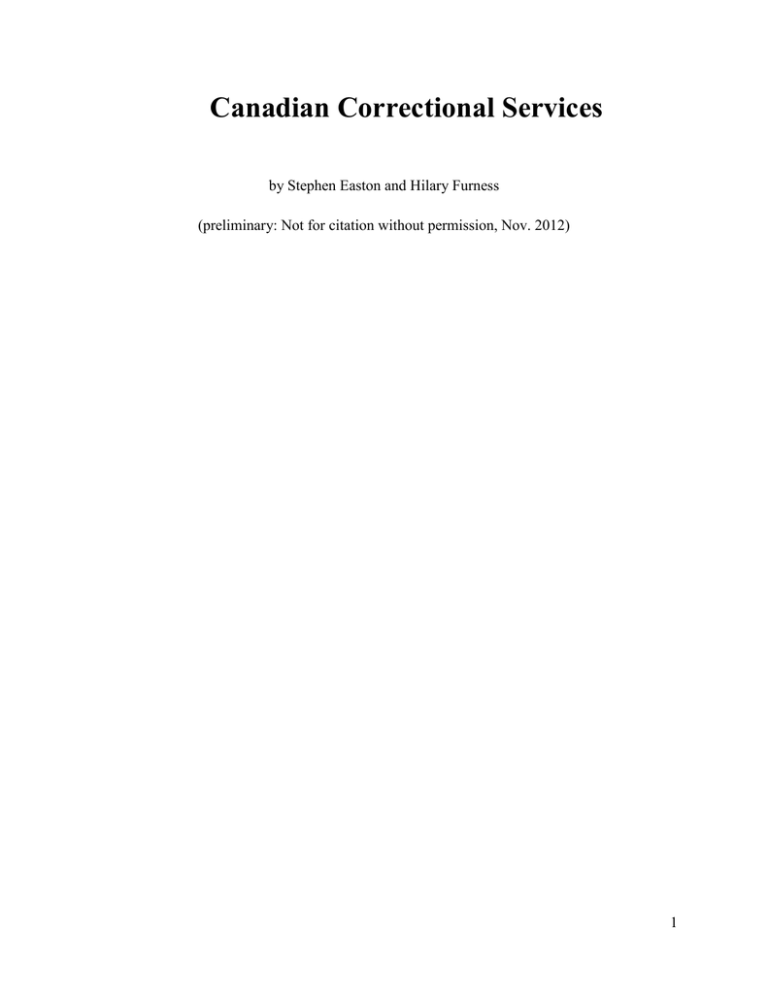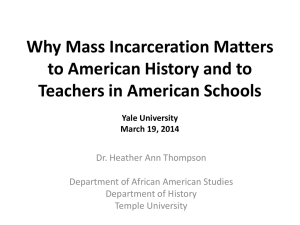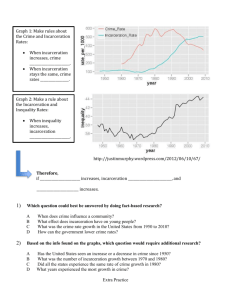Canadian Correctional Services by Stephen Easton and Hilary Furness
advertisement

Canadian Correctional Services by Stephen Easton and Hilary Furness (preliminary: Not for citation without permission, Nov. 2012) 1 Once the police catch the offender, the ultimate Canadian sanction is incarceration. This is an expensive undertaking. The governance of the offenders who are sent to the Canadian Correctional Services is a shared provincial and federal responsibility. Canadian Correctional Services consists of two principle activities: custodial sanctions and community sanctions. The first deals with imprisonment, while the second monitors probation and parole when the offender is granted some community access, or if conditional sentencing and monitoring is pursued as an alternative to incarceration. A penal sanction of two years less a day means that the guilty party is overseen by provincial and territorial authorities. The federal system governs the regulation of those who receive a sentence of two years or more. However, all community based corrections are regulated at the provincial and territorial levels (Landry & Sinha, 2008). There are several ways to measure incarceration in Canada. We can look at new admittances to correctional institutions which give a sense of the volume of activity and the number of people passing through the system (although of course the same person can be admitted more than once.) The second way is to look at average counts. Both are discussed below. New admittances to Corrections Over 374,000 individuals were admitted to Canadian Correctional Services in 2008 1 which was about the same as in 2007 of whom 70 percent were placed in provincial custody. Of these, nearly 60% of the custodial entrants were housed in remand which describes those who are awaiting disposition of their cases and who are either deemed not fit to be released on a surety, or those who choose to remain in custody 2. The increasing number in remand is a dramatic change from the past about which more will be said below. In addition to custodial sentences, there were a total of 112,034 persons who started community supervision programs of whom seventy-five percent were placed on probation, while 16% began conditional sentences (that place offenders in community and stipulate court imposed rules for a specific period of time.) Table 19 below reports the numbers of those entering specific correctional divisions for 2008/2009. 1 Note that this is the latest year the information has been made available. It may seem peculiar that people would choose to remain in custody awaiting trial, but judges have typically given “two for one” or even more. This means that upon a guilty verdict and sentence, the time before sentencing would count at least double against the time meted out by the sentence. This practice has been sharply curtailed by recent legislation (February 22, 2010, Bill C-25: An Act to amend the Criminal Code (limiting credit for time served)), that limits credit for time served to up to one day per day except in extraordinary circumstances, but also permits time served to be given no credit against sentence. To grant additional credit up to 1.5 to 1, the court is required to explain why (Calverly, 2010). 2 2 Table : Canadian Correctional Services Admissions 2008 Custodial Sanction Prov./terr. sentenced custody Remand Other temporary detention Total Prov./Terr. custody 81,806 153,774 18,164 253,744 Federal custody Total custodial supervision 8,323 262,067 Community Based Sanction Probation Provincial parole Conditional sentences Total Prov./Terr. community supervision Community releases1 Total community supervision 84,281 1,333 18,404 104,018 8,016 112,034 Source: Statistics Canada (Table 251-0001) used in conjunction with Calverley 2010 (Table 1) for the breakdown of the community corrections (community releases into parole and other) Average counts Although admissions gives a sense of the level of activity in correctional services, for many issues the average count of offenders is more useful. From Table 20 we can see that in 2008, 37,201 adults were held in custody on an average day 3. Of this total, 23,307 were held in sentenced custody, 13,507 were held in remand, and 387 were held in other forms of detentions. The Canadian incarceration rate per 100,000 adults in 2008 was 141 – slightly less than a 1% increase from 2007 which was the same as in 1998, and a 3% increase from 1988 (Statistics Canada1. (2011). Table 251-0004) In addition to those in custody, 119,965 people were, on average, under community supervision each day in 2008. Similar to patterns of new admissions, the vast majority (98,596) were on probation. Of the daily number of 13,506 offenders serving conditional sentences, approximately 7,166 per day were out on conditional release. Table: Average Counts of those in Correction's Care in 2008 Disposition Sentenced custody Remand Other temporary detention Total in Custody Incarceration rate per 100,000 adults Probation number Conditional sentence Provincial parole Total community sentences Total provincial and territorial Federal Total 9,964 13,507 13,343 … 23,307 13,507 387 23,858 ... 13,343 387 37,201 90 98,596 13,506 696 51 ... ... ... 141 98,596 13,506 696 112,798 7,166 119,965 3 However, since we used 2008 figures for the number of admissions, we use 2008 for the average counts for comparability and consistency. 3 From Table 3 of Donna Calverly, Average counts of persons in adult correctional services, by program and jurisdiction, 2008/2009 http://www.statcan.gc.ca/pub/85-002-x/2010003/article/11353-eng.htm By Province Table 21 shows the levels of incarceration by province and crime rate. The interesting thing from a policy perspective is that the rate of incarceration is simply proportional to the crime rate in a province. If we look at the major provinces, an increase in the crime rate by 100 (per 100,000) leads to an average of 1.5 more incarcerations (per 100,000). Crime and Punishment Province/Territory Incarceration rate rate per 100,000 adult population Crime Rate Newfoundland and Labrador 68 6,719 Prince Edward Island 83 6,181 Nova Scotia 59 6,964 New Brunswick 71 5,519 Quebec 72 4,735 Ontario 87 4,470 Manitoba 177 9,793 Saskatchewan 187 12,667 Alberta 104 8,117 80 8,452 Yukon 303 20,996 Northwest Territories 843 46,603 Nunavut Canada 684 141 39,628 British Columbia From Table 3 of Donna Calverly, Average counts of persons in adult correctional services, by program and jurisdiction, 2008/2009 http://www.statcan.gc.ca/pub/85-002-x/2010003/article/11353eng.htm; and CANSIM Table 2520051 for crime rates. 4 Trends, or their lack, in the use of correctional services Figure 47 displays the rates of incarceration in Canada from 1978 to 2010. What is immediately apparent is that there are few changes over this forty year period. The rate of incarceration overall has remained remarkably stable with the federal rate falling slightly in the past fifteen years and the provincial rate rising slightly in the past five years. Surprisingly, there is little evidence that the rate of incarceration is directly responsive to the crime rate although there are some gradual waves that may correspond to lagged responses to crime. Figure: Incarcerations Rates in Canada: 1978-2010 Incarceration Rates Canada 1978-2010 180 160 Rate per 100,000 adjults 140 120 100 Federal Provincial Total 80 60 40 20 0 1975 1980 1985 1990 1995 2000 2005 2010 2015 Crime and Incarceration Rates in Canada 1962-2010 We would expect the rate of incarceration to be related in a general way to the crime rate. This is only broadly the case as displayed in Figure 48. The left hand axis is the rate of incarceration per 100,000 adults. The right hand displays a measure of the crime rate per 100,000 of the total population. Although there is a general correspondence of direction in the sense that both were trending upwards until the mid 1990s and downwards through 2005, the crime rate (as extensively discussed above) has continued to fall since 1991 while the incarceration rate has 5 remained at roughly the same levels since the late 1970s. This is a puzzle since it would be natural to expect at least some correspondence between them. Looking at either the violent or property crime rates does not diminish the puzzle. Figure: Rates of Crime and Incarceration The Rates of Incarceration and Crime 180 12000 160 10000 120 8000 100 6000 80 60 Rate per 100,000 Rate per 100,000 adults 140 Incarceration Rate Crime Rate 4000 40 2000 20 0 19 7 19 8 7 19 9 8 19 0 8 19 1 8 19 2 8 19 3 8 19 4 8 19 5 8 19 6 8 19 7 8 19 8 89 19 9 19 0 9 19 1 9 19 2 9 19 3 9 19 4 9 19 5 9 19 6 9 19 7 9 19 8 9 20 9 0 20 0 0 20 1 0 20 2 0 20 3 0 20 4 0 20 5 0 20 6 0 20 7 08 20 0 20 9 10 0 Source: Statistics Canada Tables 2510004, 2520051 and Table The role of remand in incarceration rates At least part of the puzzle has to do with the role of remand in the measured rates of incarceration. As discussed above, remand is the process whereby an accused is held in custody rather than being released and having some conditions placed on him by a judge. While the actual rates of incarceration have little changed over the past thirty-five years, the mix of measured incarceration has changed dramatically. Figure 49 “With and Without Remand” shows that were the numbers on remand to be kept out of the total, the number incarcerated – those who have been sentenced and so forth – have actually mirrored the crime rate rather well by peaking in the mid 1990s and falling thereafter. 6 Figure: The Incarceration Rate With and Without Remand: 1978-2010 Incarceration with and without Remand 180 160 140 Rate oer 100,000 Adults 120 100 Total Total Less Remand 80 60 40 20 0 1975 1980 1985 1990 1995 2000 2005 2010 2015 Source: Statistics Canada Table 251-0004 (v21536766 Canada; Total actual-in count (Persons) and v44182162 Canada; Remand, actual-in count (Persons)). This is used in conjunction with Statistics Canada Table 051-0001 for population statistics. More directly, in Figure 50 below, we can see that the remand rate now dominates the provincial incarceration rates. Note further that without including the Remand Rate, both the Federal Incarceration Rate and the Provincial Incarceration Rate fall roughly in proportion to the decreasing crime rate. The Remand Rate stands in sharp opposition to these trends. The rate of provincially (sentenced) incarcerated persons peaked at 54 (per 100,000) in 1982 while in 2009 the rate had dropped to 29. These numbers suggest a total decline in the rates of 45%. On the other hand, since 1978, the rates of those held in remand have increased nearly 4% per annum. Remand rates have increased over 189% since 1982 (Statistics Canada1, 2011; Statistics Canada2, 2011). 7 Figure: Remand and Federal and Provincial Rates of Incarceration Federal, Provincial Less Remand and Remand 80 70 Rate per 100,000 Adults 60 50 Fed Prov Less remand Remand 40 30 20 10 0 1975 1980 1985 1990 1995 2000 2005 2010 2015 Source: as in Table The Figure displays the ratio of remand to sentenced custody across the provinces (read off the left hand axis) together with the crime rate (on the right hand axis). The amount of remand is not evenly spread around the country, nor does it appear to be a function of the crime rate. If we look at the ratio of remand relative to those in sentenced custody in Figure 51 below, we see that the big users of remand are not necessarily those with the highest levels of crime. Thus it is hard to understand why it is that such high rates of remand appear where they do. The greatest use of remand is in Manitoba and Ontario, and yet they have dramatically different crime rates: Manitoba having one of the highest provincial crime rates and Ontario the lowest. Saskatchewan has the highest crime rate among the provinces but is in the middle of the pack as far as the use of remand. 8 Figure: Remand and Crime Rate by Province Remand and Crime Rates by Province Bars: Ratio of Remand to Senetenced Custody 2.50 14000 10000 1.50 8000 6000 1.00 4000 0.50 Crime Rate per 100,000 of population 12000 2.00 2000 0.00 ol um bi a ta C is h Br it ch e ka t Sa s Al be r w an a ito b M an io nt ar O be c ue Q w ic k N ew ov a N ar d Ed w Pr in ce Br un s d Is la n or br ad La d an d dl an N ew fo un Sc ot ia 0 Source: Source: Table 2520051 and Calverly, Table 3, http://www.statcan.gc.ca/pub/85-002x/2010003/article/11353/tbl/tbl03-eng.htm The important conclusion from figure is that the stress on remand is not simply a question of some proportionality with the crime rate. It is an interaction of the players in the justice systems of the different provinces. Just as clearly it not a question of size since Ontario and Manitoba are so different yet they share a common remand rate. It is not an “east-west” relationship since while BC and Alberta are relatively similar in both crime rates and remand rates, they are more or less in the middle of the population pack and have remand rates much like the smaller province of Nova Scotia. Quebec, a large province, has both a low crime rate and a low remand rate while Ontario has a low crime rate and a high remand rate. The source of the differences among remand rates is an important question. Is it a matter of sentencing? Do some provinces systematically treat accused sufficiently differently so as to encourage them to remain without bail? Is it some mix of offences that requires this peculiar combination of remand? Will the new federal legislation return the ratios of remand to older rates? Most importantly, is remand a good use of our resources? Community Corrections and Probation 9 Displayed in Figure probation for 104,000 miscreants comprises the highest volume of correctional services while 13,000 were serving conditional sentences in 2010 The use of community corrections 4 and probation increased dramatically from the late 1980’s to the early 1990’s but fewer people are being sentenced to probation since the mid-1990s (Statistics Canada1, 2011; Statistics Canada2, 2011.) Presumably this is in some measure a reflection of the falling crime rate. Figure: Community sentencing and probation 425 Rate per 100,000 375 325 275 225 Community Probation 175 Source: Statistics Canada Table 251-0004 (v21536769 Canada; Total community supervision count (Persons) and v21536770 Canada; Probation, community supervision (Persons)). This is used in conjunction with Statistics Canada Table 051-0001 for population statistics. Look to Excel Workbook “Average counts of provincial and federal offenders (2510004) 1-3” More interestingly, if we look at the use of probation relative to the crime rate, we get a very different story. By looking at the ratio, we are implicitly asking how likely it is that an offence would be to receive probation. Figure 53 plots the ratio of probation relative to the crime rate. 4 Conditional sentences comprised 11% of all community corrections involvement in 2009 (Statistics Canada1, 2011) rising steadily during the 1990s until leveling off around 2000. 10 Figure: The Ratio of Probation per Crime Known to the Police 12,000.00 0.0500 0.0450 10,000.00 8,000.00 0.0400 0.0350 0.0300 6,000.00 0.0250 Crime Ratio: Probation to Crime Rates 0.0200 4,000.00 2,000.00 0.0150 0.0100 0.0050 0.00 0.0000 1975 1980 1985 1990 1995 2000 2005 2010 2015 Sources: http://www.statcan.gc.ca/daily-quotidien/110721/longdesc-c110721e.htm; and as per Table C3. The sharply increased likelihood of an offence receiving probation is apparent. This is a trend that has taken place since the mid-1980s and show no sign of declining. Thus the fall in the number receiving probation is in fact less than the fall in the crime rate itself. In this sense probation is clearly more frequently used now than ever before. Sentence lengths Over the past thirty years sentence lengths in prisons have changed dramatically. In 1978 an offender’s expected sentence length was 5.13 years; in 2008 it had fallen to 4.47 5 (Statistics Canada4, 2011). In 1978 34% of those serving time in a federal institution were assigned sentences of two to three years 6, forty-three percent were to serve three to six years, 10% were 5 Look to Excel booklet “Sentence lengths – in percent” to see how I did this. Recall that federal prison is for those who receive custody sentences of two or more years while provincial jails house those who received sentences of less than two years. 6 11 given six to nine year terms, and 9% would serve nine years to life (Statistics Canada4, 2011). By 2008 the proportion of offenders given two to three year sentences increased by half to 52% while the granting of each of the other terms to convicted persons had decreased (Statistics Canada4, 2011). The percentages of offenders admitted to custody with three to six year and six to nine year terms had fallen to 35% and 6%, respectively Figure C5 describes the fraction of federal offenders by the duration of their sentence. In each case the bars describe the fraction for each of the three years 1978, 1992 and 2008. The data for 1978 illustrate a period in which there was relatively low rates of crime, 1992 is at the peak of Canada's crime mountain, and 2008 illustrates the recent events. Below the Figure illustrates the increase trend in two to three year sentences. Figure: The Changing pattern of sentences in Federal Incarceration: 1978-2008 60 50 Pcercent 40 30 1978 20 1992 2008 10 0 Years of Sentenced Incarceration Source: Statistics Canada Table 251-0003 (v21536723 to v21536735). Look to Excel Workbook “Sentence lengths – In percent” for more information What the figure illustrates is that the fall in the average length of sentence has primarily been a result of the fraction of offenders receiving shorter sentences. This has been taking place more or less independently of the crime rate since the increase in shorter terms was relatively stable 12 between 1978 and 1996 and then rose steadily from 1996 to 2003 at which point it once again stabilized at roughly 50 percent of all inmates. Expenditures Canadians spend nearly $4 billion on corrections: from custody to parole services. The path of these expenditures is displayed in Figure 5. Figure: Total corrections expenses (2011 dollars) Total Corrections Expenditures (2011 $) 4.5E+09 4E+09 3.5E+09 3E+09 2.5E+09 2E+09 1.5E+09 1E+09 500000000 0 1975 1980 1985 1990 1995 2000 2005 2010 Sources: All 2008 expenses were taken from Statistics Canada tables 251-0007 and 326-0020 rebased to 2011 using CPI from CANSIM v41693271. In 2008/2009 Canadian Corrections cost Canadians upwards of $3.8 billion or $115.76 per capita (Calverley, 2010 Table 12). This figure marked an inflation adjusted increase of 7% from the previous year (Calverley, 2010 p. 16). Nearly three-quarters of the expense (71%) was allotted to custodial services while 13% and 14% respectively were spent on community services and headquarters and central services (Calverley, 2010 Table 12). Column 2 of Table 22 displays the cost of corrections services in Canada in 2008 (the last year for which data are available). Column 3 adjusts these expenditures to 2011 dollars. Column 4 identifies the average annual growth in real costs that have taken place in broad categories of correctional expenses since 1978. What is noteworthy is that over the 29 years of the table, the increase in corrections expenditures are on average 3.6 percent per year above the rate of inflation! 13 Table : Correctional Expenses: 1979-2008 2008 Expenses( in 2008 $) Division Custodial 2008 Expenses ( in inflation adjusted 2011 $) Average Annual Percent Increase in real costs 19792008 2,750,385,000 2,890,194,229 3.10% Community 509,867,000 535,784,867 5.90% Headquarters 538,222,000 565,581,225 58,742,593 4,050,301,863 4.90% Parole Total 55,901,000 3,854,374,000 3.80% 3.6% Sources: All 2008 expenses were taken from Statistics Canada table 251-0007. Percentage change figures are derived from Statistics Canada tables 251-0007 and 326-0020; CPI from Cansim: v41693271 adjusted to 2011 base. What the custodial dollar is being spent upon has also changed slightly over the past 30 years with less being associated with custody itself and more with other aspects of corrections services. Table : Shares of the Corrections Canada Expenses: 1979-2008 Shares of the Corrections Canada Expenses: 1979-2008 Custodial Community Headquarters Parole 1979 0.769 0.099 0.118 0.014 2008 0.714 0.132 0.140 0.015 % Change -0.07 0.34 0.19 0.04 Sources: Table 23 shows that the custodial expenses have fallen as a share of total expenditures while community services, parole and headquarters services have all risen. There has clearly been a change in emphasis as custodial sentences have decreased in duration, and more offenders are “doing time” in the community. The expenditure on headquarters services has also risen. Looking at the cost per day of housing inmates in Figure 56 (the figures are in real 2011 dollars per day), it is clear that although federal costs have understandably always been more expensive than provincial costs, since the early 1990s when they were almost equivalent, the daily costs of federal incarceration have doubled while provincial costs have remained at roughly the same levels. Thus the increase in the average daily cost of incarceration is primarily a Federal cost increase and it is one that has been taking place for the past fifteen years. 14 Figure: The Daily Cost of Federal and Provincial Incarceration (2012 $) 400 350 300 250 Provincial 200 Federal 150 100 50 0 1978 1988 1998 2008 Source: Statistics Canada: Cansim series v21537001 and v21537125 grossed up to 2012 prices. 15





